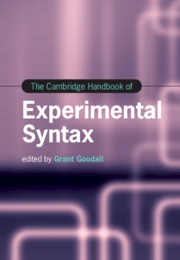Book contents
- The Cambridge Handbook of Experimental Syntax
- The Cambridge Handbook of Experimental Syntax
- Copyright page
- Contents
- Figures
- Tables
- Contributors
- Introduction
- Part I General Issues in Acceptability Experiments
- 1 Sentence Acceptability Experiments: What, How, and Why
- 2 Response Methods in Acceptability Experiments
- 3 Approaching Gradience in Acceptability with the Tools of Signal Detection Theory
- 4 Variation in Participants and Stimuli in Acceptability Experiments
- 5 Acceptability, Grammar, and Processing
- 6 Satiation
- 7 Acceptability (and Other) Experiments for Studying Comparative Syntax
- Part II Experimental Studies of Specific Phenomena
- Part III Experimental Studies of Specific Populations and Language Families
- Part IV Experimental Syntax beyond Acceptability
- Index
- References
6 - Satiation
from Part I - General Issues in Acceptability Experiments
Published online by Cambridge University Press: 16 December 2021
- The Cambridge Handbook of Experimental Syntax
- The Cambridge Handbook of Experimental Syntax
- Copyright page
- Contents
- Figures
- Tables
- Contributors
- Introduction
- Part I General Issues in Acceptability Experiments
- 1 Sentence Acceptability Experiments: What, How, and Why
- 2 Response Methods in Acceptability Experiments
- 3 Approaching Gradience in Acceptability with the Tools of Signal Detection Theory
- 4 Variation in Participants and Stimuli in Acceptability Experiments
- 5 Acceptability, Grammar, and Processing
- 6 Satiation
- 7 Acceptability (and Other) Experiments for Studying Comparative Syntax
- Part II Experimental Studies of Specific Phenomena
- Part III Experimental Studies of Specific Populations and Language Families
- Part IV Experimental Syntax beyond Acceptability
- Index
- References
Summary
Satiation refers to an increase, over time, in the willingness of a native-speaker consultant to agree that a given syntactic structure is grammatically well-formed. Studies show that satiation can be induced under laboratory conditions, within a single testing session; that the effect is restricted to a small number of sentence types (chiefly those involving wh-extraction from wh-islands, subjects, and certain complex NPs); that experimentally induced satiation can persist for at least four weeks; and that satiation sometimes ”carries over” to syntactically related sentence types. Tables are provided showing the methods and findings of satiation studies on seven different types of syntactic violation. Larger issues include (i) whether the satiable sentence types form a natural class within generative syntax; (ii) whether satiation is a unitary phenomenon, or merely a family of similar phenomena; and (iii) how, in principle, satiation can serve as a tool for language research.
Keywords
- Type
- Chapter
- Information
- The Cambridge Handbook of Experimental Syntax , pp. 154 - 180Publisher: Cambridge University PressPrint publication year: 2021
References
- 2
- Cited by

